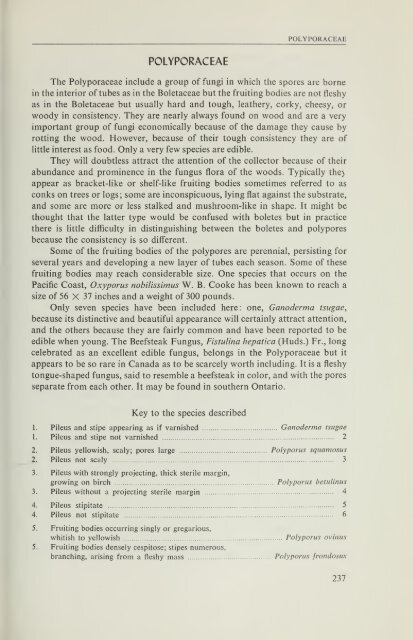You also want an ePaper? Increase the reach of your titles
YUMPU automatically turns print PDFs into web optimized ePapers that Google loves.
POLYPORACEAE<br />
POLYPORACEAE<br />
The Polyporaceae include a group of fungi in which the spores are borne<br />
in the interior of tubes as in the Boletaceae but the fruiting bodies are not fleshy<br />
as in the Boletaceae but usually hard and tough, leathery, corky, cheesy, or<br />
woody in consistency. They are nearly always found on wood and are a very<br />
important group of fungi economically because of the damage they cause by<br />
rotting the wood. However, because of their tough consistency they are of<br />
Httle interest as food. Only a very few species are edible.<br />
They will doubtless attract the attention of the collector because of their<br />
abundance and prominence in the fungus flora of the woods. Typically the}<br />
appear as bracket-hke or shelf-like fruiting bodies sometimes referred to as<br />
conks on trees or logs ; some are inconspicuous, lying flat against the substrate,<br />
and some are more or less stalked and mushroom-Hke in shape. It might be<br />
thought that the latter type would be confused with boletes but in practice<br />
there is little difficulty in distinguishing between the boletes and polypores<br />
because the consistency is so different.<br />
Some of the fruiting bodies of the polypores are perennial, persisting for<br />
several years and developing a new layer of tubes each season. Some of these<br />
fruiting bodies may reach considerable size. One species that occurs on the<br />
Pacific Coast, Oxyporus nobilissimus W. B. Cooke has been known to reach a<br />
size of 56 X 37 inches and a weight of 300 pounds.<br />
Only seven species have been included here: one, Ganoderma tsugae,<br />
because its distinctive and beautiful appearance will certainly attract attention,<br />
and the others because they are fairly common and have been reported to be<br />
edible when young. The Beefsteak Fungus, Fistulina hepatica (Huds.) Fr., long<br />
celebrated as an excellent edible fungus, belongs in the Polyporaceae but it<br />
appears to be so rare in Canada as to be scarcely worth including. It is a fleshy<br />
tongue-shaped fungus, said to resemble a beefsteak in color, and with the pores<br />
separate from each other. It may be found in southern Ontario.<br />
Key to the species described<br />
1. Pileus and stipe appearing as if varnished Ganoderma tsugae<br />
1. Pileus and stipe not varnished 2<br />
2. Pileus yellowish, scaly; pores large Polyporus squamosus<br />
2. Pileus not scaly 3<br />
3. Pileus with strongly projecting, thick sterile margin,<br />
growing on birch Polyporus betulinus<br />
3. Pileus without a projecting sterile margin 4<br />
4. Pileus stipitate 5<br />
4. Pileus not stipitate 6<br />
5. Fruiting bodies occurring singly or gregarious,<br />
whitish to yellowish<br />
5. Fruiting bodies densely cespitose; stipes numerous,<br />
branching, arising from a fleshy mass<br />
Polyporus ovinus<br />
Polyporus frondosus<br />
237

















